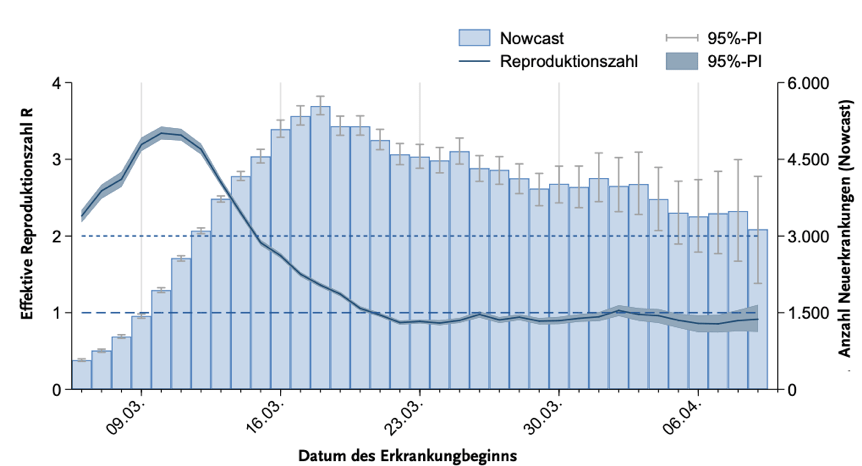Global virus lockdown was ‘madness’
Tue 5:50 am +01:00, 5 May 2020Renowned German scientist calls lockdown ‘incredibly harmful’ to individuals and economy

Stock image of a German flag in a surgical mask in the Covid-19 era. Image: Facebook
4 May, 2020 by UWE PARPART
It was called “lockdown madness.” But the line was not coined on some obscure conspiracy-mongering website. And, no, it was not part of a rant from US President Donald Trump.
Instead, “Lockdown Wahn” (lockdown madness or insanity) is the term first used by Stefan Homburg, the professor of public finance at Leibniz University in the German city of Hannover. His interview with famed YouTube channel moderator Milena Preradovic on April 17 went viral.
Homburg’s point, since repeated on numerous occasions and included in a debate in Germany’s federal parliament, the Bundestag, was simple and based on a now-famous graphic produced by the Robert Koch Institut. For those unfamiliar with the RKI, it is a German government agency responsible for disease control and prevention, or the equivalent of the US Centers for Disease Control (CDC).
The principal line graph, below, represents the “reproduction number,” also known as “Ro or “R naught,” of an infectious disease. This is the number of cases, on average, an infected person will cause during their infectious period.

What the RKI’s Ro graph (just R in German) shows is that by March 23 when the government ordered its harshest set of lockdown measures, the reproduction figure was already below 1, meaning that the number of new infections was on the decline. Not only that, Ro in the following weeks, while staying below zero, did not decline further. So, as the lockdown continued, it accomplished no additional reduction in new cases.
In the Preradovic interview, Prof Homburg called the lockdown “totally superfluous” and “incredibly harmful,” not only to the economy, but also to the psychological and physical well-being of uncountable individuals who were prevented from having lifesaving operations or were contemplating suicide.
Homburg further pointed out that the RKI released to the public irresponsibly high numbers of potential deaths from Covid-19 – “300,000 to 1.5 million.” At the time of the lockdown decision, it must have known, or should have known, that the figures were vastly exaggerated.
Since the Homburg interview and a follow-up one with Preradovic on April 24, it is now clear that his concerns were borne out. The latest Ro number published by the RKI on April 30 was 0.75, meaning the number of new infections over any given reference period (four days) goes down by 25%.
Moreover, data from EuroMOMO, the European Union agency monitoring mortality and aiming to detect excess deaths over seasonal influenza, showed a narrow spike over the recent 2017 high. But that has since returned to within a normal range and below the 2017 peak.

Homburg’s conclusions that the decision to announce a total lockdown on March 23 was made in haste are now supported by numerous epidemiologists and other medical specialists. At the time, he argued that the was not enough adequate data to support the decision or a reliable assessment of the dangers posed by the coronavirus.
Dr Klaus Pueschel, the director of the Institute of Forensic Medicine at Hamburg University, which has conducted more than 150 autopsies of people who had died of the virus, said that 80% of the deceased had prior cardiovascular illnesses. The average age of those examined by the Institute was 80 years.
In numerous interviews on German national television, Pueschel said that “this is not a killer virus” and that the “fear that large numbers will die from it are exaggerated.”
Prof Surachit Bhakdi, an internationally renowned epidemiologist and microbiologist who headed up the Mainz University Institute for Microbiology and Infectious Diseases, said on April 29 that the lockdown was “nonsensical” and “self-destructive.”
Moreover, the issue has become a hot topic in the German parliament, with Chancellor Angela Merkel defending the lockdown decision in her government declaration of April 23, in which she called the pandemic an “imposition to democracy.”
Earlier, Bundestag President and former Minister of Finance Wolfgang Schaeuble had said in the lower house of parliament that in this crisis “not everything can be made subordinate to the protection of life.” He added, “that there were other basic human rights that must be safeguarded, first and foremost human dignity.”
Wolfgang Kubicki, the vice-president of the Bundestag, wrote in the daily Die Welt that “the state must trust and respect” the decisions of responsible citizens on what risks they were willing to take.”
“It cannot be that measures are undertaken over an extended period of time that are destructive to the economy and the very basis for the existence of millions,” he said.
Those voices have become even louder as it becomes clear that the pandemic in Germany at least has peaked. As of April 30, 161,539 people in Germany had become infected with the death-toll hitting 6,467, according to data from Johns Hopkins University. The death rate inched up to 4% from 3.95% a day earlier, while the number of people who had recovered held at 120,400.
In part, of course, the defeat dealt to Covid-19 was due to the disciplined response of the majority of citizens and to the resolute, timely and competent actions of the government, particularly in wide-spread testing.
But it must also be said that as of April 30, Sweden, which did not engage in a nation-wide lockdown has like Germany attained a Ro number below one.
Finally, there is more than a distinct possibility that future historians of the Covid-19 pandemic will conclude that the measures taken were not proportional to the dangers posed by this new strain of coronavirus.
Source: https://asiatimes.com/2020/05/global-virus-lockdown-was-madness/










